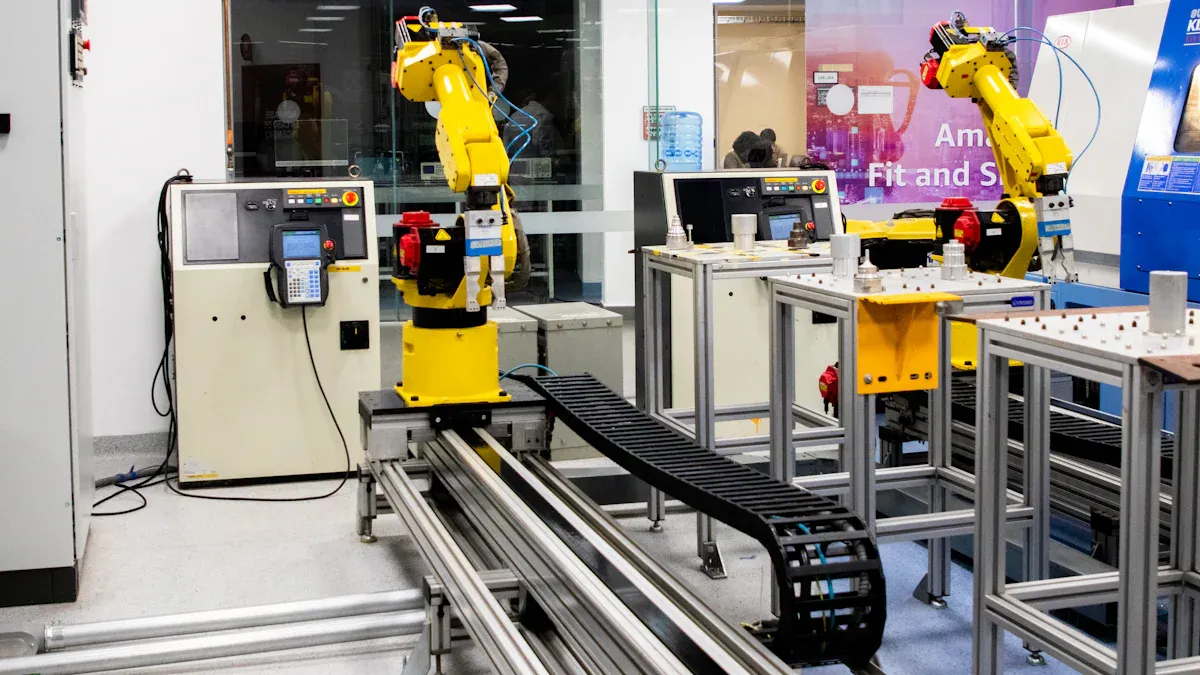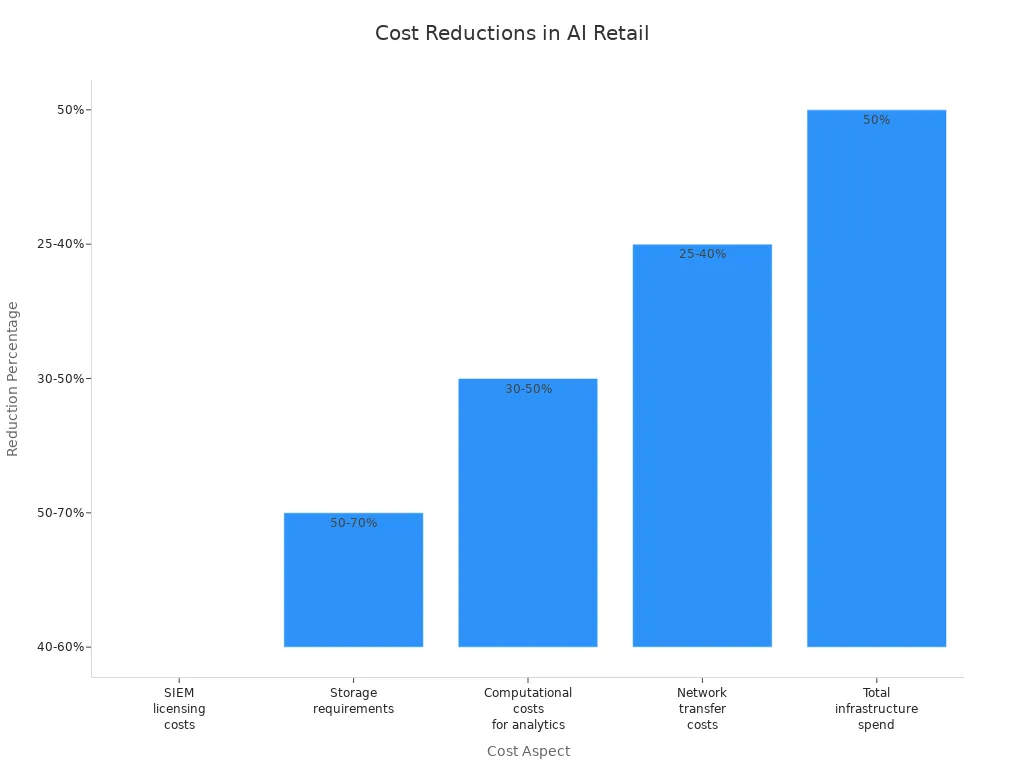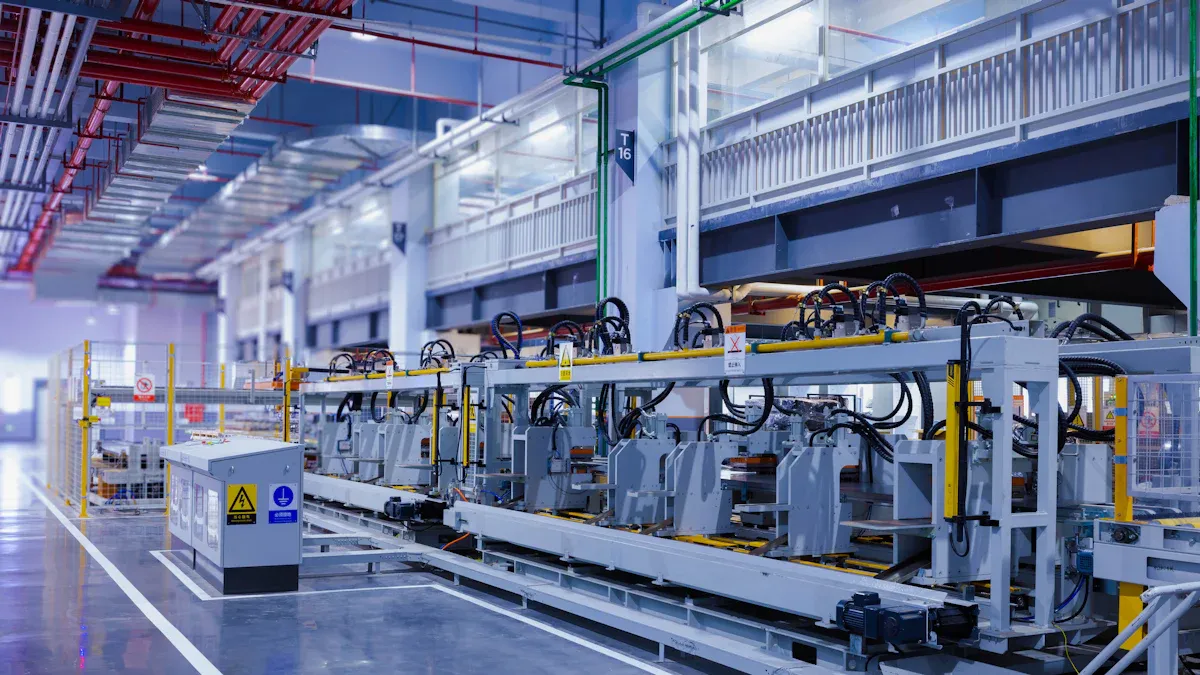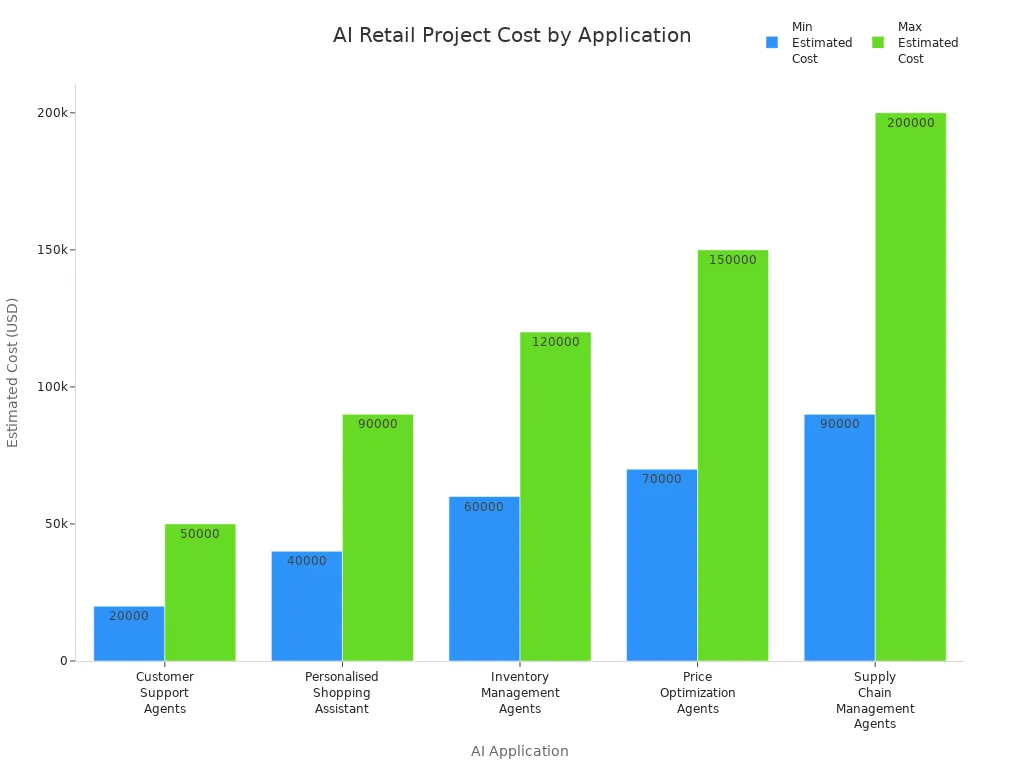Cost of building ai retail store hardware

You might wonder, "How much does it actually cost to build AI retail store hardware?" The numbers can surprise you. For a mid-sized store, hardware investment often lands between $25,000 and $100,000. If you want custom solutions or advanced features, costs can climb past $500,000. Factors like project complexity, your team’s expertise, and the technology stack play a huge role in shaping the cost of building your setup. Store size and the amount of data you need also matter, so knowing every component helps you budget smarter.
Key Takeaways
Budget wisely. Costs for AI retail hardware can range from $10,000 to over $500,000. Start with a clear budget to avoid surprises.
Understand the components. Your total cost includes hardware, software, integration, data storage, and maintenance. Each part affects your overall spending.
Choose wisely. Select hardware that meets your needs without overspending. Start with basic options and upgrade as your store grows.
Plan for ongoing costs. Expect yearly software licensing fees of $30,000 to $50,000 and maintenance costs of around $9,000 to $15,000 annually.
Consider cloud solutions. They offer lower initial costs and flexibility, allowing you to scale your AI capabilities as needed.
Cost of Building: Overview
Total Cost Range
When you start planning your AI retail store, you probably want to know the price tag. The cost of building your hardware and software can change a lot depending on what you need. Some stores spend as little as $10,000 on basic hardware. Others invest $100,000 or more for advanced systems. If you want a full solution with custom features, the cost of building can reach $500,000 or even higher.
Here’s a quick look at what different AI solutions might cost:
| Type of AI solution --- | Cost range --- | | Chatbots --- | $5,000 - $20,000 --- | | Image recognition --- | $15,000 - $200,000+ --- | | Recommendation engines --- | $10,000 - $200,000+ --- | | Natural Language Generation (NLG) --- | $20,000 - $200,000+ --- | | Fraud detection & prevention --- | $30,000 - $300,000+ --- | | Predictive analytics --- | $20,000 - $40,000+ --- | | Speech recognition --- | $10,000 - $30,000+ --- |
You also need to think about deployment and ongoing costs. Setting up everything can cost between $80,000 and $190,000. Software licensing usually adds $30,000 to $50,000 every year. These numbers help you see how much you might spend, but your final cost depends on your choices and store size.
Tip: Start with a clear budget. This helps you avoid surprises and keeps your project on track.
What’s Included
So, what do you actually pay for when you build an AI retail store? The cost of building covers several main parts. Each one plays a big role in how much you spend.
Hardware: This includes things like GPUs, TPUs, sensors, cameras, servers, and kiosks. You need these devices to run AI models and collect data.
Software & Licensing: You pay for AI software, apps, and licenses. Some solutions need yearly payments to keep everything updated.
Integration: You might need to connect new AI tools with your existing systems. This can mean extra work and extra cost.
Data & Storage: AI needs lots of data. You pay for storing, managing, and protecting this information.
Maintenance: Keeping your hardware and software running smoothly costs money. You need updates, repairs, and support.
Each part affects your total cost. If you choose high-end hardware or advanced AI features, your budget goes up. If you pick basic options, you save money. Knowing what’s included helps you plan better and make smart decisions.
Cost Breakdown

Hardware
When you start planning your AI retail store, hardware is one of the first things you need to think about. The cost of building your setup depends a lot on the devices you choose. You might need GPUs or TPUs for running AI models, sensors to track movement, cameras for security and analytics, servers to process data, and kiosks for self-checkout.
Here’s a quick look at what you might pay for each:
Cameras can cost less than $50 for basic models. High-end cameras can go over $3,000 each.
GPU instances usually cost between $0.50 and $10 per hour.
TPU usage ranges from $2 to $40 per hour.
The price goes up if you want more advanced features or higher-quality equipment. If you run a large store or want to track lots of data, you’ll need more hardware, which increases the cost of building your system.
Tip: Start with what you need most. You can always add more hardware later as your store grows.
Software & Licensing
Software is the brain behind your AI retail store. You need to pay for the programs that run your AI models, manage your data, and help you make smart decisions. The cost of building your software stack depends on how complex your system is.
Here’s a table to show what you might spend on different types of AI software:
Feature | Estimated Cost |
|---|---|
Basic AI Chatbot | $5,000 – $15,000 |
AI Recommendation Engine | $20,000 – $50,000 |
AI Inventory Management | $30,000 – $100,000 |
Fully Integrated AI Retail Platform | $100,000 – $500,000+ |
If you want more advanced features, like a full AI-powered platform, you’ll pay more. Some software also needs yearly licensing fees, which can add $30,000 to $50,000 every year. Always check if updates and support are included in the price.
Integration
Integration means connecting your new AI tools with the systems you already use. This step can be simple or complex, depending on your store. If you only need to add a small app, it costs less. If you need to connect many systems or work with old technology, the cost of building your solution goes up.
Here’s what you might pay for integration:
Integration Scenario | Typical Cost Range |
|---|---|
Simple app integration | $8,000 – $20,000 |
Multi-system workflows | $20,000 – $45,000 |
Integrating AI with legacy systems | $30,000 – $70,000 |
Some things can make integration more expensive:
You need to protect customer data and follow privacy rules.
You want to avoid bias and make sure your AI is fair.
You have to train your team to use new tools.
You need to upgrade old systems to work with new AI.
Note: Integration can take time. You might not see savings right away, but it helps your store run better in the long run.
Data & Storage
AI needs lots of data to work well. You have to store, manage, and protect this data. The cost of building your data system depends on how much information you collect and how secure you need it to be.
Cloud storage costs about $400 per terabyte each year. If your store uses 40-80 terabytes, you’ll pay $16,000 to $32,000 per year.
On-premises storage can cost up to $30,000 to set up, plus $10,000 each year for maintenance.
Some stores spend $10,000 per year for basic storage, but big companies can spend over $500,000 if they need a full data team.
You can save money by reducing how much data you store or by using smarter analytics. Here’s a chart that shows how you can cut costs in different areas:

Maintenance
Once your AI retail store is up and running, you need to keep everything working. Maintenance covers software updates, technical support, data management, and security. The cost of building your system includes planning for these ongoing needs.
Most stores spend $8,999 to $14,999 each year on maintenance.
You pay for regular software updates, support, and keeping your data safe.
Here’s a table that shows the most important maintenance tasks and how they affect your costs:
Maintenance Activity | Description | Cost Implications |
|---|---|---|
Software Updates and Upgrades | Regular updates to improve performance and add new features. | Extra costs for big changes. |
Technical Support | Help to fix problems and keep things running. | Ongoing support fees. |
Data Management and Storage | Handling all your store’s data. | High costs for secure storage and processing. |
Data Security Measures | Protecting your data from threats. | More costs for advanced security. |
Tip: Good maintenance keeps your store running smoothly and helps you avoid bigger repair bills later.
By understanding each part of the cost of building your AI retail store, you can make smart choices and avoid surprises. Start with what you need most, and plan for both the setup and the ongoing costs.
Influencing Factors

Store Size
Store size plays a big role in your total costs. If you run a large retail space, you need more cameras, sensors, and servers. You also need advanced AI to manage customer flow and optimize layouts. Smaller stores can focus on targeted AI, like personalizing offers or making checkout faster. Here’s a quick table to show how store size affects your spending:
Store Size | AI Application | Cost Implication |
|---|---|---|
Large Retail Spaces | Layout optimization, customer flow management | Higher costs due to sophisticated solutions needed |
Small Retail Spaces | Hyper-personalization, operational efficiency | Lower costs with targeted AI applications |
Hardware Choices
Your hardware choices can make a big difference. If you pick high-end GPUs, advanced sensors, or top-tier cameras, you’ll pay more up front. Basic hardware costs less, but may not support every AI feature you want. Think about what your store really needs. Sometimes, starting with simple devices and upgrading later works best.
Tip: Choose hardware that matches your goals. You don’t need the most expensive gear to get started.
AI Complexity
The more complex your AI, the higher your costs. Simple AI tools are cheaper and easier to set up. If you want advanced models that predict trends or analyze video in real time, you’ll need more money and expert help. Here’s what happens when you go for complex AI:
You face higher implementation costs.
You might run into system compatibility problems.
You often need specialized experts, which increases your project costs.
Data Needs
AI loves data, but storing and managing it can get expensive fast. If you want real-time analytics or process huge amounts of information, your bills will climb. Some retailers have seen their storage costs triple in just one year. One online marketplace’s CTO even said the flood of data made costs hard to control. When you plan your project, think about how much data you really need.
Storage costs rise as you collect more data.
Some companies see data expenses triple each year.
Managing lots of information means paying a premium for data management.
Integration Level
How well your new AI fits with your current systems affects your budget. If you have modern, API-ready systems, integration is smoother and cheaper. Outdated tech can make things tricky and expensive. Upgrading old systems before adding AI can actually save you money over time.
Modernizing legacy systems before or during AI setup can cut your total cost of ownership by 20–30% over five years.
If you use outdated technology, you might pay 40–60% more for integration than stores with modern systems.
When you look at all these factors, you see why the cost of building an AI retail store can change so much. Plan carefully, and you’ll get the best value for your investment.
Cost Examples
Small Store
If you run a small retail shop, you can start with basic AI features. You might use a few cameras, simple sensors, and a basic chatbot. The cost of building your setup usually stays low. Most small stores spend between $10,000 and $50,000 for hardware and software. You can add more features later as your business grows.
Basic cameras and sensors: $2,000 – $10,000
Entry-level AI chatbot: $5,000 – $15,000
Simple integration: $8,000 – $20,000
Tip: Start small and upgrade as you learn what works best for your customers.
Medium/Large Store
Medium and large stores need more advanced AI. You might want inventory management, personalized shopping assistants, and customer support agents. Costs go up as you add more features and connect more systems.
AI Application | Complexity Level | Estimated Cost | Why It Costs More |
|---|---|---|---|
Customer Support Agents | Medium | $20,000 – $50,000 | Needs language processing and CRM links |
Personalized Shopping Assistant | High | $40,000 – $90,000 | Real-time personalization and catalog links |
Inventory Management Agents | High | $60,000 – $120,000 | Predictive analytics and ERP integration |
Price Optimization Agents | High | $70,000 – $150,000 | Real-time data and pricing engine links |
Supply Chain Management Agents | Very High | $90,000 – $200,000 | Advanced models and logistics integration |
You can see how the cost of building your AI system grows as you add complexity. Here’s a chart that shows the range for different applications:

Flagship Store
Flagship stores go all out with AI. You might use custom AI services, advanced machine learning, and even generative AI models. These stores often need edge-optimized AI, which lets you run powerful features across your whole network. The cost of building a flagship store can start at $100,000 and go over $1 million.
Custom AI services: $10,000 to $500,000+
Third-party software: Free to $40,000 per year
Basic AI automation: $5,000 – $50,000
Machine learning models: $20,000 – $200,000
Generative AI models: $50,000 – $500,000
Custom solutions: $100,000 – $1,000,000+
You also save money in the long run by using smarter hardware. For example, you might only need 4 GPUs instead of 50, which lowers your capital costs. Faster processing and less memory use help you get a better return on your investment.
Note: Flagship projects cost more up front, but they can save you money and boost your store’s performance over time.
Cost Optimization
Off-the-Shelf Components
You can save a lot by choosing off-the-shelf components for your AI retail store. These ready-made solutions often come with lower upfront costs because the vendor handles most of the development and maintenance. However, you might pay subscription fees over time, and you may not get every feature you want. Here’s a quick look at the trade-offs:
Cost Aspect | Description |
|---|---|
Lower Initial Costs | Off-the-shelf solutions usually have reduced upfront costs since the vendor manages maintenance and development. |
Subscription Fees | You may pay ongoing fees based on how much you use and the support you need. |
Limited Customization | These solutions are affordable but may not fit every unique business need. |
Tip: Off-the-shelf options work best if you want to launch quickly and keep things simple.
Phased Approach
A phased approach helps you control the cost of building your AI system. You start with a small pilot project that targets one or two key areas. This way, you can see results fast and avoid spending too much at once.
You can focus on manageable use cases first.
Cloud-based AI platforms and subscriptions keep your upfront costs low.
A phased rollout can cut your initial costs by 20–30%.
Start with high-value projects to see benefits sooner.
Only connect essential systems at first to manage expenses.
Note: You can always add more features later as your store grows.
Cloud Solutions
Cloud solutions make it easier to manage costs and scale your AI hardware. You pay a subscription fee instead of buying expensive equipment. Cloud platforms also handle updates and security for you. Here’s how cloud and on-premise solutions compare:
Aspect | Cloud VMS Benefits | On-Premise VMS Trade-offs |
|---|---|---|
Initial Costs | High upfront costs for hardware | |
Operational Costs | Predictable, scalable fees | Ongoing costs for power and IT staff |
Scalability | Easy to grow and add locations | Need to buy more hardware to scale |
Accessibility | Access from anywhere with internet | Only works on local network |
Security | Data encrypted in secure centers | You control data, but face physical risks |
Maintenance | Provider handles updates | You must manage updates and repairs |
Cloud solutions help you stay flexible and avoid big surprises in your budget.
Vendor Negotiation
Smart vendor negotiation can lower your total costs. AI tools can help you find savings and make better deals. Some companies have saved up to 15% by using AI in their procurement process. Others have cut raw material costs by 4% or saved 5–7% on supplier contracts.
Evidence Type | Description |
|---|---|
Cost Savings Potential | AI in procurement can reveal savings of up to 15%. |
Data Gaps | 72% of buyers lack the data needed for strong negotiations. |
Efficiency Gains | AI boosts efficiency, cost control, and productivity for retailers. |
One CPO in consumer goods cut raw material costs by 4% with AI negotiation.
A tech firm saved 5–7% on low-value contracts using AI tools.
Tip: Gather as much data as you can before you negotiate. The more you know, the better deal you’ll get.
You now know the main cost drivers for AI retail store hardware. The cost of building depends on your hardware, software, data needs, and how complex your setup is. To keep your project on track, follow these steps:
Step | Description |
|---|---|
Plan your implementation | Set a clear roadmap to avoid extra expenses. |
Scale resources strategically | Pick cloud or hardware based on your needs. |
Use performance monitoring tools | Catch issues early and keep things running well. |
Conduct regular audits | Check your systems often for savings. |
Optimize your budget continuously | Always look for ways to cut waste. |
Talk to experts and compare quotes before you decide. Remember to budget for both the start and the ongoing costs.
FAQ
How much does it cost to start with basic AI hardware?
You can get started for around $10,000. This covers simple cameras, sensors, and basic software. If you want more features, you will spend more.
Do I need to pay for software every year?
Most AI software needs yearly licensing fees. You should expect to pay $30,000 to $50,000 each year for updates and support.
Can I use cloud solutions to save money?
Yes! Cloud solutions help you avoid big upfront costs. You pay a monthly fee and scale up when you need more power.
What hardware do I need for a small store?
You need a few cameras, basic sensors, and a simple server or cloud access. This setup keeps costs low and helps you get started fast.
How can I lower my total costs?
Tip: Start small, use off-the-shelf components, and negotiate with vendors. You can also choose cloud services to avoid buying expensive hardware.
See Also
Starting Your AI-Driven Corner Store on a Budget
Understanding the Growth of AI-Enhanced Convenience Stores
The Future of Retail: Embracing AI-Driven Stores
Modern Retail Advantages of AI-Integrated Combo Vending Machines
